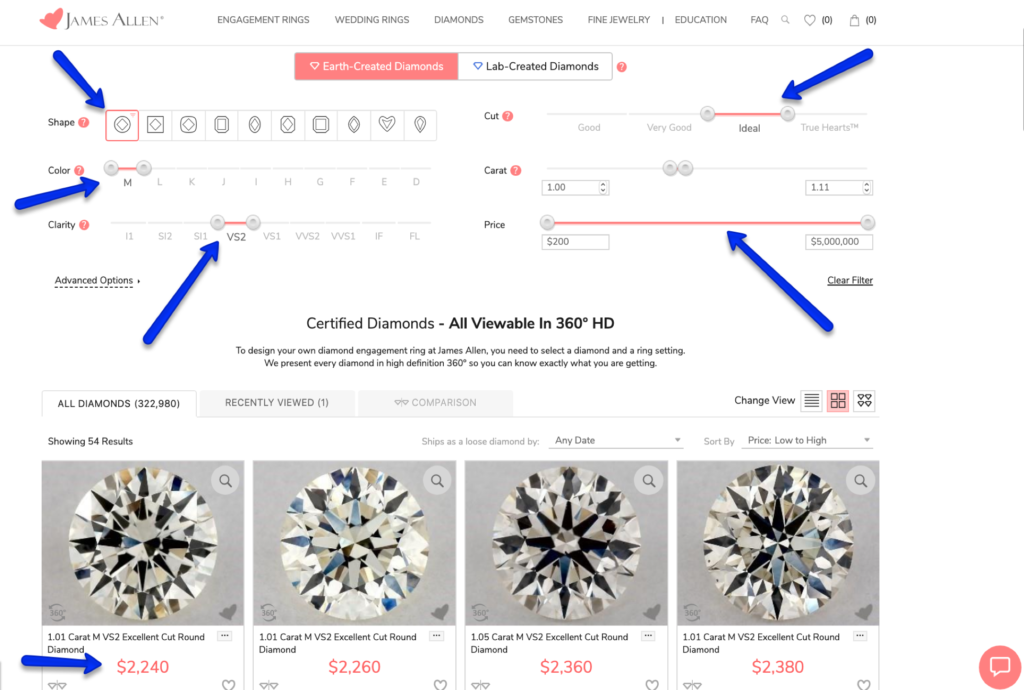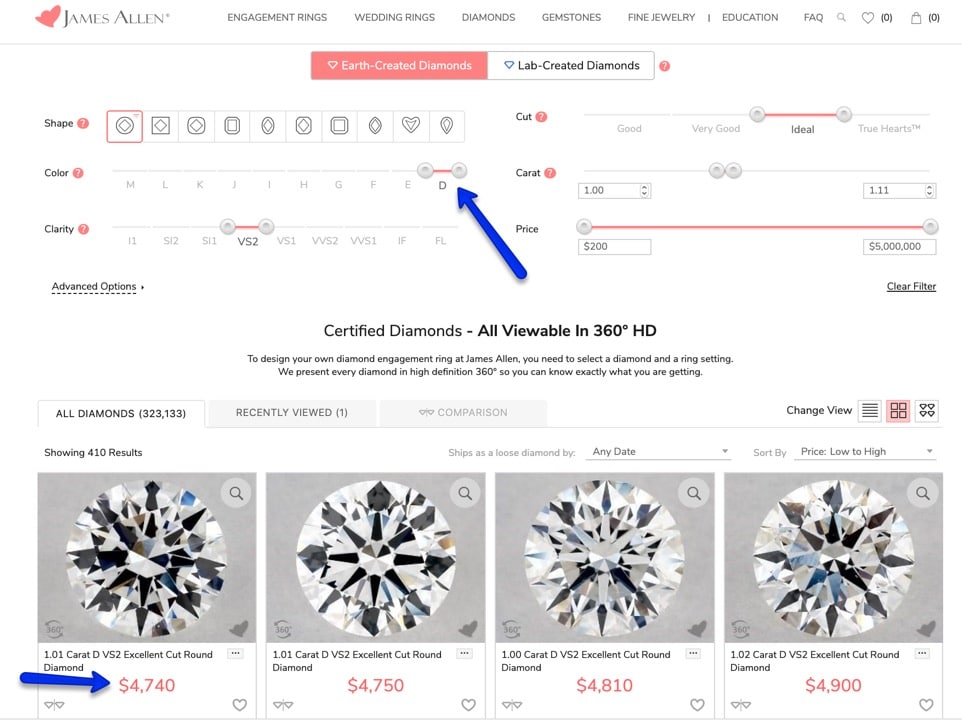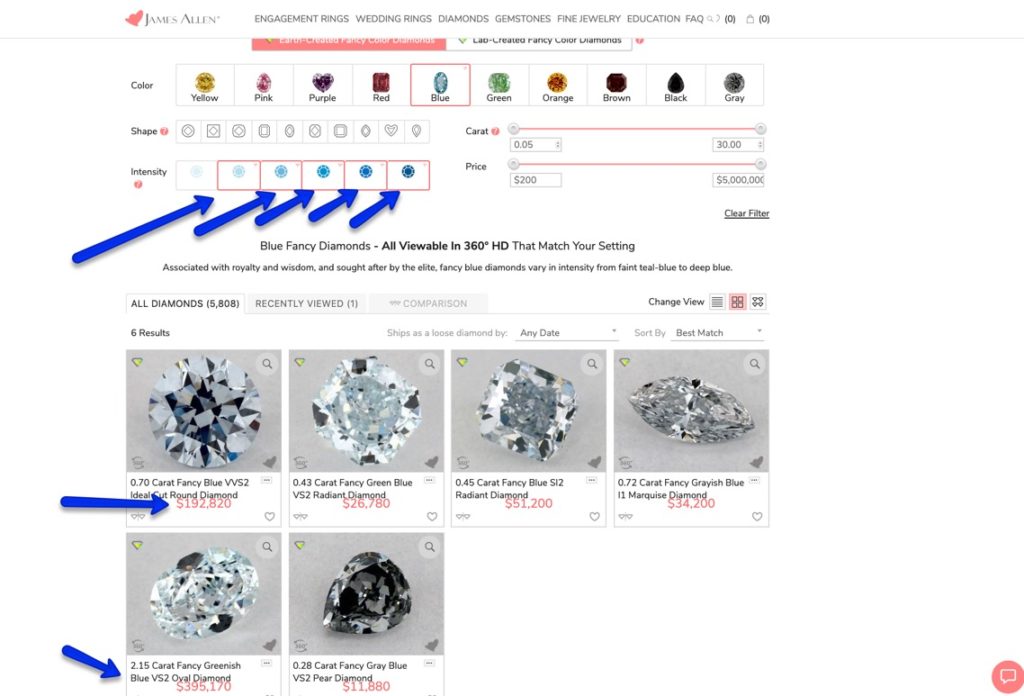I’m glad you’ve stopped in to read this quick, crucial overview of diamond color. Now you won’t make a decision without knowing some crucial facts.
Even if you’re pretty familiar with what diamond color is, you’re about to learn at least one or two things that will positively affect the soundness of your decision in buying a diamond engagement ring.
For example:
- Did you know that not all color in diamonds is “bad”?
- Did you know that some quite darkly colored diamonds can be hundreds of times more valuable than some diamonds on the colorless scale?
- Did you know that “Fancy Color,” as odd as that term sounds at first, is a GIA designation for a class of colored diamonds other than the traditional colorless or white diamonds? (GIA is of course the Gemological Institute of America, the most respected authority in diamond grading.)
If you give me just 10 minutes of your time reading, you’re going to make a better decision, I promise, based on new information you learn in this quick article.
- You’ll avoid getting ripped off. (Getting ripped off isn’t uncommon, now that so many diamonds are sold via the Internet.)
- You’ll avoid making a mistake that could for a lifetime affect your satisfaction — or your beloved’s — with the ring.
- You’ll gain confidence in your own tastes, so that you can relax and choose the diamond engagement ring that you and your beloved really want. Not just follow the crowd.
What Is the Best Diamond Color?
The best, most desired color of diamond is absolutely colorless. At least, that’s true by market demand and popular acclaim. What about you and your tastes? You’ll explore on your own very soon in this article.
But first let’s look at longstanding valuations of diamonds, so you’ll know the lay of the land you’re going to explore.
A perfectly colorless diamond is considered the best, and most valuable. It’s also a very rare find.
Being able to objectively see that a diamond is colorless is a rare skill, requiring education and training. That’s why every honest player in the diamond space relies on GIA-trained gemologists who examine and grade diamonds under specialized conditions and neutral light. (Other organizations also certify diamonds, The American Gemological Society or AGS among them. But I think the GIA is the most respected, all things considered.)
You can’t rely on a jeweler’s product description to determine color. You can’t rely on your own eyes. You can only rely on one thing: the color grade listed in the diamond’s official certificate.
Ripoff red flag: A diamond which doesn’t have a GIA or AGS (American Gemological Society) certificate. Other organizations’ certificates might also be trustworthy, but in my opinion, GIA is preferred and AGS is acceptable. Personally I wouldn’t rely on any other group’s diamond grade. I don’t have data to back up my low opinion of other, minor certification groups. But I know the reputations of GIA and AGS are solid, so those are the only two I’ll recommend to our readers.
Two Kinds of Color
Did you know that there are two classes of diamond color?
- The first is “Colorless.” Also known as the GIA White Diamonds Color-Grade Scale
- The second is the GIA Fancy Color classification, which gets complex but we’ll cover it further down this page.
Colorless diamonds or white diamonds (the two terms refer to the same diamonds) are of course what most people think of as diamonds. The less color in this class of diamonds, the better.
Most “colorless” diamonds have some amount of yellow. That may be a barely-visible trace of yellow for which even a trained gemologist must look closely, under specialized conditions. Or it may be quite a bit more. See the descriptions below:
Colorless Diamonds
All of the letter grades below refer to “Colorless Diamonds,” or “White Diamonds” (Again, these two terms refer to the same thing.)
- D through F are “Colorless”
- G through J are “Near Colorless”
- K through M are “Faint” color
- N through R are “Very Light” color
- S through Z are “Light” color
Points to Note About the Colorless Grades From D to Z
Most jewelers don’t carry Colorless diamonds of color grades beyond about L, which is to say from M through Z. The reason is that they’re not desirable enough to bother with, for jewelry. Most people just don’t want them. For example:
- James Allen doesn’t carry Colorless diamonds of N through Z.
- Blue Nile doesn’t carry Colorless diamonds of M through Z.
How Do the D Through M Color Grades Affect Price?
It’s complicated, because the price of any diamond is a function of (to oversimplify): Color, Clarity, Carat Weight, and Cut.
A good way to begin to get a sense of how color affects price is to play with the color grade slide filter at this shopping page at James Allen.
Set all the sliders as shown below. This will make sure you isolate only Color grade as a variable.

Adjust both ends of the color slide to step up one by one from M to D. Watch those prices rise!
But they don’t rise exponentially. See what happened when I got to D:

A Tip for Saving Money in the Colorless Class of Diamonds
If you’re like me, maybe you never gave much thought to the color of diamonds, before you fell in love sufficiently to begin looking at engagement rings.
It’s hard for me to see color in diamonds. I’m not the only one. Especially diamonds that aren’t hulking pieces of shining gemstone.
Even for those with some experience in diamonds, color is hard to see until you hit at least the 1-carat frontier, and beyond.
So if you’re buying a diamond that will tip the scale at under 1 carat, and especially if you’re buying diamonds for a pavé ring or cluster engagement ring, or a floral engagement ring, you really can settle for I, J, or K color diamonds.
No dignity lost. Hardly anyone will notice. It’s between you and your spouse
Are you patiently hunting the 1-carat and above prey? Then definitely go with at least a color grade of H, and preferably I or better.
Don’t Trust Anyone (Except the Grading Scale on the Certificate)
“DTA” is always a little emo and overstated. But it’s fun to say.
I really should say “Trust, But Verify.”
When the difference in price between one little shade and the next can be hundreds of dollars, there’s a built-in motivation for unscrupulous sellers to exaggerate.
Even if a jeweler is sincere, they may be inexpert. Only the GIA certificate should be trusted. It’s because making these judgments can be so difficult. Only a certified grading professional should determine a diamond’s color grade.
What If There’s No Gia Certificate for a Diamond? Is It Okay If It “Looks” Colorless?
Then don’t walk, run for the door. That’s equivalent to 99 red flags, each with a siren alarm.
To put it plainly, there’s no question that is definitely a bad deal. It could even be a cubic zirconia.
But even a real diamond without a certificate is kind of like a home without a deed, or a car without a registration.
The lack of a certificate is an absolute dealbreaker. Never ever consider buying a diamond without a GIA or at least an AGS (American Gemological Society) certificate.
Without a certificate, you just don’t know what you’re getting. Which, in a transaction this expensive, is almost always because the seller doesn’t want you to know what you’re getting.
If it were an awesome diamond, the seller would definitely prove that to you with a certificate.
Fancy Color Diamonds
Have you ever wondered what happens to, say, yellow diamonds that are beyond the grade of Z in the GIA scale?
They exist.
Are they just thrown into a rock pile? Hardly.
Are they all shipped off to spend this blip in their billions-year old existence on the razor-tipped teeth of industrial saw blades?
Not all of them.
You’re going to love this.
At least, I do. Because they’re beautiful, if you put aside traditional aesthetic prejudices, which more and more people are learning to do in the diamond markets.
Fancy Color Yellow Diamonds
Diamonds that have too much yellow color saturation to qualify even as Z in the GIA colorless scale can get into another club run by the GIA. And that’s the Fancy Yellow diamond club.
These beautiful diamonds, which in former times were doomed to serve as industrial diamonds, can now be seen for what they always were: truly beautiful gemstones, billions of years old, which we have the privilege of enjoying and admiring.
And gifting.
And wearing.
It really makes sense aesthetically, when you see them.
Have a look at the Fancy Yellows at James Allen.
- Fancy Light = Least saturated with Yellow
- Fancy
- Fancy Intense
- Fancy Vivid
- Fancy Deep
- Fancy Dark = Most saturated with Yellow
Fancy Color Brown Diamonds
The next most common Fancy Color diamond, recognized by the GIA, is Fancy Color brown diamonds.
They range from almost yellow, champagne colored diamonds to a deep cocoa color.
If you’d like to look into Fancy Color Brown diamond, you should check out the incredible selection at James Allen.
The Range of Fancy Color Brown
- Fancy Light = Least saturated Brown
- Fancy
- Fancy Intense
- Fancy Vivid
- Fancy Deep
- Fancy Dark = Most saturated Brown
Are you beginning to see the pattern? It’s the same vocabulary used to describe the Yellows.
With Colors, Things Get Complicated and Beautiful
In reality — which is where diamonds live, having been around for literally billions of years — colors of natural objects do not fit neatly into specific categories. There are always gradations.
In human cognition and communication, we can still make meaningful classifications. And the GIA has done this. But don’t mistake the words for reality.
Don’t make the self-hypnotic mistake of believing all Fancy Vivid Brown diamonds are the same color.
They simply aren’t.
That would be like mistaking the menu for the steak.
Now that you have ventured this far into the exploration of the colors of diamonds, you have left theory and have begun to enter reality.
So you can begin to trust what you like. And trust what your beloved likes.
Use the GIA-defined color grades and vocabulary as signposts in the exploration of this romantic and intriguing landscape of diamond color. These signposts will prevent you getting ripped off, especially in the colorless “White” class of diamonds.
But pursue what you like, what gives you and your beloved pleasure, as you shop for colorless diamonds or for Fancy Color diamonds.
Set Sail at James Allen, Exploring Fancy Color
Rather than stretch this post out with details and classifications of all the Fancy Color diamonds, I will more usefully pull up the anchor and give you the tiller.

Earth created blue diamonds are among the most rare diamonds you can shop for.
Notice all of the top four saturation levels have been selected. And yet only six diamonds in all of James Allen are pulled up from the vault of the database!
How rare they are, and the preciousness is reflected in the price.
Even if you’ll never buy a blue diamond, they’re a work of nature and humanity worth seeing, if only online.
It’s kind of thrilling, even if it makes me somewhat queasy, to know that someone, somewhere, is paying these incredible prices.
And some beloved, somewhere, will receive, perhaps, one of these very stones on a diamond engagement ring.
